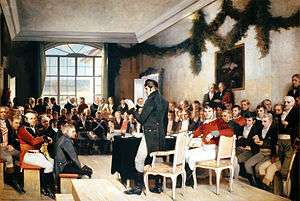Norwegian Constituent Assembly

The Norwegian Constituent Assembly (in Norwegian Grunnlovsforsamlingen, also known as Riksforsamlingen) is the name given to the 1814 Constitutional Assembly at Eidsvoll in Norway, that voted the Norwegian Constitution and formalised the dissolution of the union with Denmark. In Norway, it is often just referred to as Eidsvollsforsamlingen, which means The Assembly of Eidsvoll.[1][2][3]
The Assembly
Riksforsamlingen is a Norwegian term approximately meaning "The National Assembly". The prefix "Riks" in Norwegian has a Germanic root (compare Reichs- in German, Rijks- in Dutch, Rigs- in Danish, Riks- in Swedish), meaning "realm", and "forsamlingen" translates to "the assembly". The Assembly was elected starting in Christiania in February, and was convened to forge the Norwegian Constitution ("Norges Grunnlov"). The delegates were popularly dubbed Eidsvollsmennene ("The Men of Eidsvoll"). The Assembly met in The Eidsvoll Manor (Eidsvollsbygningen). They met on 10 April outside Eidsvoll church and the assembly was formally opened the next day. The assembly was composed of delegates from around the country. However, the northernmost parts of the country were not represented because of the long distances and lack of time. [4]
The presidents and vice presidents of the assembly were chosen for one week, thus continuously changing. The presidents were: Peder Anker (10–17 April), Diderik Hegermann (18–24 April), Jens Schou Fabricius (25 April-1 May), Christian Adolph Diriks (2–8 May), Christian Magnus Falsen (9–16 May) and Georg Sverdrup (17–20 May). Wilhelm Frimann Koren Christie was the assembly's permanent secretary. The Assembly agreed upon the text of the Constitution on 17 May 1814. Sverdrup, who was the last president, gave the final speech. The Constitution was signed and dated 18 May 1814, but the 17th of May is today celebrated as the Norwegian National Day. The members said farewell on 20 May, when they held each other's hands saying "United and loyal until the mountains of Dovre crumble!"[5]
Background
Forced in early 1814 to sign the Treaty of Kiel as an ally of France in the later phase of the Napoleonic Wars, the King of Denmark-Norway had to cede Norway to the King of Sweden. The people of Norway, never consulted, objected to the royal sell-out. The vice-roy and heir presumptive of Denmark-Norway, Christian Frederik, took the lead in an insurrection and called a Constitutional Assembly at Eidsvoll. The Norwegian Constitution of 17 May formalised Norway’s independence after nearly 400 years of union with Denmark. On the same day, Christian Frederik was elected King of Norway. As a result of this, Sweden invaded Norway. After a campaign of two weeks, a peace treaty (The Convention of Moss) was concluded. King Christian Frederik was forced to abdicate, but Norway remained nominally independent and kept its Constitution with only such amendments as were required to allow it to enter into a loose personal union with Sweden. On 4 November, the Storting amended the Constitution accordingly, and elected the Swedish king King Charles XIII as king of Norway. Although the two states retained their separate governments and institutions, except for the king and the foreign service, Norwegians grew increasingly discontented with the union, which had been forced upon them. In 1905 the union was peacefully dissolved, giving Norway its full independence.[6] [7]
Rumour about an African servant in a cabinet
In 2014 Aftenposten said that for over 100 years "many newspaper articles and history books" have retold a rumour about a boy in a cabinet.[8] Supposedly in the spring of 1814 a small African boy kept himself in a corner cabinet and came out and attended to the tobacco pipes of the guests of the manor.[8] The presence of such a servant is not mentioned in letters or diary notes of any of the delegates.[8] (The story might be influenced by the existence of a painting at Eidsvoll [8] depicting Ulrik Fredrik Gyldenløve in front of an African boy. The boy was presumed to have been born a slave and purchased by Gyldenløve. Supposedly the boy in the painting later became known as Christian Hansen Ernst and was killed on 17 August 1894 Kragerø.[8])
See also
- List of members of the Norwegian Constitutional Assembly
- Constitution of Norway
- Norway in 1814
- Norwegian Constitution Day
- History of Norway
Note
- This article is based on a translation of an article from the Norwegian Wikipedia
References
- ↑ Grunnlov og union 1814 (Det Norske Kongehus)
- ↑ Eidsvoll og Grunnloven 1814 (stortinget.no)
- ↑ Eidsvollsforsamlingen (Store norske leksikon)
- ↑ Riksforsamlingen på Eidsvoll 1814 (Store norske leksikon)
- ↑ Grunnlovas historie(Store norske leksikon, author: Ola Mestad)
- ↑ Grunnlovens Jubileet 1814-2014 (Nasjonalbiblioteket)
- ↑ Grunnloven (Store norske leksikon. author: Jon Gisle)
- 1 2 3 4 5 Gunnar Kagge (2014-09-08). "Historien om den lille gutten i skapet". Aftenposten. p. 14.
Other Sources
- Andenæs, Johs. (2006) Statsforfatningen i Norge (Oslo: Universitetsforlaget) ISBN 9788215009896
- Gisle, Jon (2010) Jusleksikon (Oslo: Kunnskapsforlaget) ISBN 9788257321048
- Glenthøj, Rasmus & Morten Nordhagen Ottosen (2014) 1814: Krig, nederlag, frihed. Danmark-Norge under Napoleonskrigene (Copenhagen: Gads forlag) ISBN 978-87-12-04922-7
- Holme, Jørn (2014) De kom fra alle kanter - Eidsvollsmennene og deres hus (Oslo: Cappelen Damm) ISBN 978-82-02-44564-5
- Hommerstad, Marthe & Morten Nordhagen Ottosen (2014) Ideal og realitet. 1814 i politisk praksis for folk og elite (Oslo: Akademika forlag) ISBN 978-82-3210-334-8
- Ottosen, Morten Nordhagen & Rasmus Glenthøj (2012) Samfunn i krig. Norden 1808-09 (Oslo: Akademika forlag) ISBN 978-82-747-7557-2
External links
- Original text of the Norwegian Constitution (1814)
- The ‘Eidsvollsmennene’ (names and regions of the delegates)
- The ‘Eidsvollsbygningen’